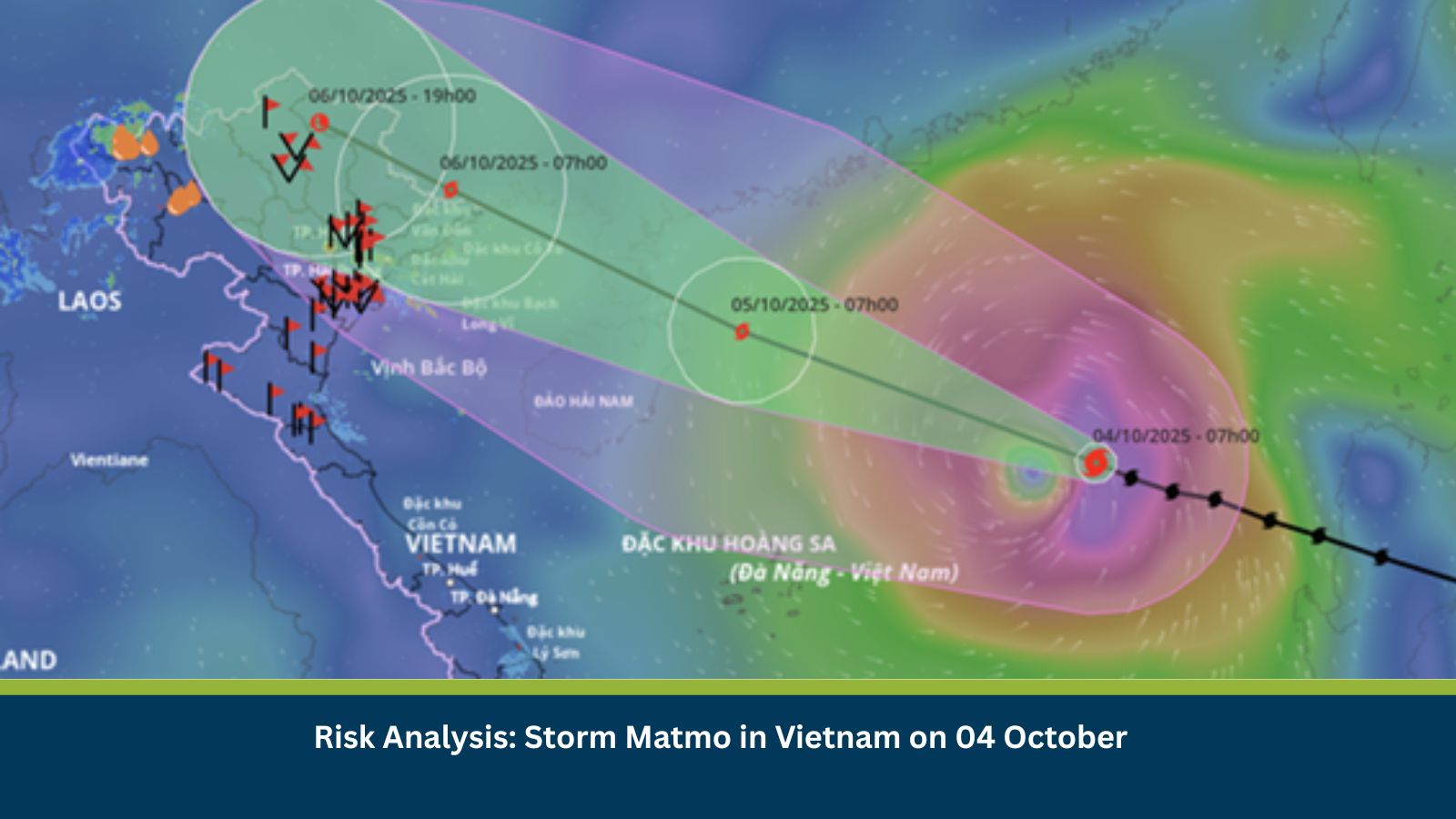What is Risk Analysis in the Context of Natural Disaster Events
Natural disaster risk analysis assesses the potential threat from extreme weather – storms, floods, or typhoons, on lives, assets, infrastructure, and economic stability. In Vietnam, tropical cyclones like Ragasa and Kajiki have historically disrupted transport, agriculture, and essential services. Understanding these recurring storm patterns enables authorities and organizations to plan evacuations, safeguard assets, and ensure operational resilience.
Executive Summary
- Date of Incident: 04 October 2025
- Location: Hanoi, Vietnam
- Risk Category: Natural Disasters
- Severity Score: 4/5
- Confidence Level: 85%
Storm Matmo continues to intensify at sea and is projected to make landfall along Vietnam’s northern and central coasts beginning 05 October. Heavy rainfall, flooding, and power disruptions are likely through 09 October. Anticipated impacts include severe damage to infrastructure, logistical bottlenecks, and safety hazards in low-lying and coastal areas.
Current Updates
As of 04 October, the Vietnam National Centre for Hydro-Meteorological Forecasting reports Matmo’s rapid intensification in the East Sea. Coastal regions from Quang Ninh to Thanh Hoa are under high alert. Evacuation advisories are expected in flood-prone and landslide-risk zones, and maritime activities have been suspended.
Known Hotspots and Sensitive Areas
- High impact: Quang Ninh, Hai Phong, Thanh Hoa – risk of flooding, strong winds, and port closure.
- Medium impact: Hanoi and Red River Delta – potential heavy rainfall, power outages, and flight delays.
- Low impact: Southern provinces – indirect rainfall and wind effects.
Storm recurrence follows established monsoon-season patterns, typically affecting the northern coast and Red River basin.
Impact on Transportation and Services
Expect complete suspension of maritime traffic, delays at Cat Bi and Van Don airports, and rail service interruptions. Flooding may cut off National Highway 1A and key provincial routes. Power, telecom, and water utilities are vulnerable to prolonged disruptions due to inundation and wind damage.
Recommended Actions
- Emergency readiness: Activate disaster response teams; secure staff in high-risk areas; follow government evacuation orders.
- Asset protection: Relocate equipment to elevated zones; secure construction materials and outdoor items.
- Operational continuity: Back up all data; ensure generator fuel reserves; shift operations to unaffected regions.
- Communication: Issue stakeholder advisories on service delays and safety measures; maintain multi-channel contact via SMS, apps, and satellite.
- Recovery planning: Prepare rapid post-storm inspection and insurance documentation.
Multidimensional Impact
The storm’s collateral effects span human, economic, and environmental dimensions. Intense rainfall threatens lives and livelihoods, particularly in coastal and agricultural areas. Flooding and wind damage could cripple logistics, supply chains, and energy infrastructure, impacting national trade through Hai Phong Port. Prolonged power and water outages may heighten health risks, while soil erosion and saline intrusion will affect future crop cycles. Cumulatively, Matmo’s effects extend beyond immediate destruction, influencing recovery timelines and regional economic output.
Emergency Contacts
- Police: 113
- Fire: 114
- Ambulance: 115
- National Centre for Hydro-Meteorological Forecasting (NCHMF): +84 (24) 3936 6757
Final Thoughts
A high-impact weather event is expected between 05–09 October, with forecasts indicating rainfall exceeding 300mm, potential port disruptions, and extended power outages across several regions. Businesses should activate continuity protocols and secure assets well in advance to minimize operational and financial risks. The strategic priority during this period must remain on protecting human life, ensuring infrastructure resilience, and maintaining transparent communication throughout the response and recovery phases. Organizations are advised to leverage early-warning systems and real-time preparedness platforms to stay updated and coordinate timely action as the situation evolves. Stay ahead of operational risks with real-time alerts, scenario modeling, and expert advisories with datasurfr’s Predict. Start your 14-day free trial of Datasurfr’s Risk Intelligence Platform today.






